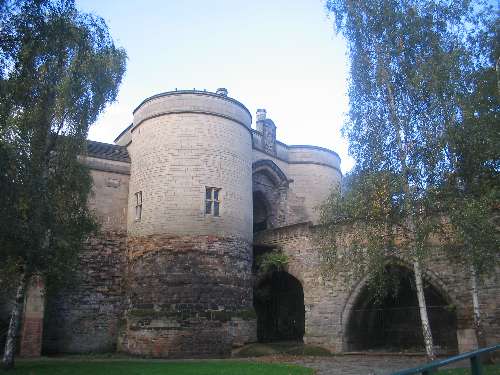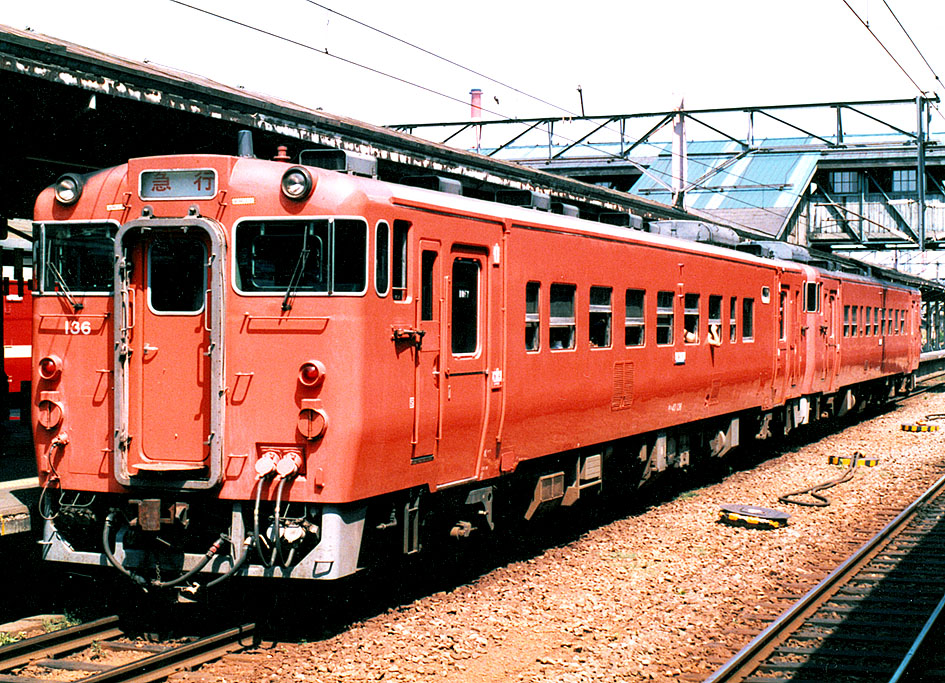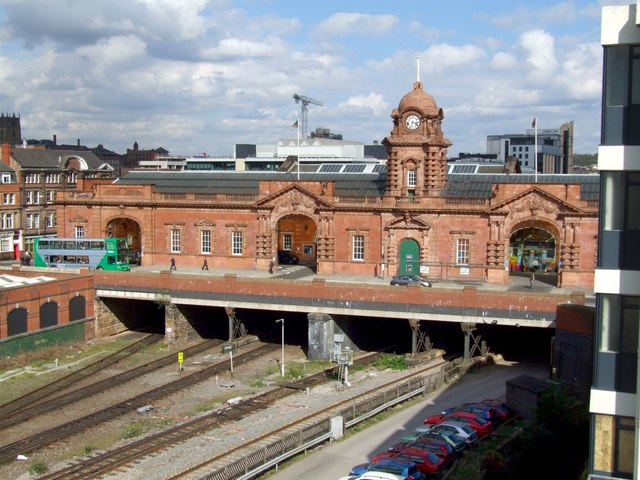|
Nottingham Eastcroft
Nottingham Eastcroft is a light maintenance depot located in Nottingham, Nottinghamshire, England. The carriage sidings are located near Nottingham station and are situated alongside the former Midland Railway line to Lincoln. The depot code is NM. Present As of 2021, East Midlands Railway / Sprinters, Express Sprinters and Turbostars are allocated and maintained here. The depot is receiving a £2 million upgrade, increasing the capacity and modernising the fuelling facilities. This work is planned to be completed in June 2022. Also present at Eastcroft is Boden Rail who maintain Class 37, Class 56 and Class 70 locomotives for Colas Rail Colas Rail is a railway infrastructure and rail freight company primarily active in the United Kingdom. It is a subsidiary of the French industrial group Bouygues. Colas Rail was originally created as ''Seco Rail'', named after its then-pare .... References Rail transport in Nottinghamshire Railway depots in England ... [...More Info...] [...Related Items...] OR: [Wikipedia] [Google] [Baidu] |
British Rail Class 60
The British Rail Class 60 is a class of Co-Co heavy freight diesel-electric locomotives built by Brush Traction. They are nicknamed ''Tugs'' by rail enthusiasts. During the 1980s, it became increasingly apparent that British Rail required a more capable Type 5 locomotive for its heavy freight trains. Dissatisfaction with the British Rail Class 56's reliability led to the stipulation of a 95 percent availability, a stringent requirement at the time. A total of three bids were received to a competitive tender issued on 10 August 1987; of these, Brush Traction's submission was selected and an order for 100 locomotives was issued during the following year. Despite the first example being completed during June 1989, due to a number of technical issues discovered during testing, the first examples of the Class 60 would not enter revenue service until late 1990. Operated only during the final years of British Rail, the entire Class 60 fleet became the property of English Welsh & Sc ... [...More Info...] [...Related Items...] OR: [Wikipedia] [Google] [Baidu] |
British Rail Class 158
The British Rail Class 158 '' Express Sprinter'' is a diesel multiple unit (DMU) passenger train. It is a member of the Sprinter series of regional trains, produced as a replacement for British Rail's first generation of DMUs; of the other members, the Class 159 is almost identical to the Class 158, having been converted from Class 158 to Class 159 in two batches to operate express services from London Waterloo to the West of England. The Class 158 was constructed between 1989 and 1992 by British Rail Engineering Limited (BREL) at its Derby Litchurch Lane Works. The majority were built as two-car sets, some three-car sets were also produced. During September 1990, the first Express Sprinters were operated by ScotRail; the type was promptly introduced to secondary routes across the Midlands, Northern England, Wales and the South West. The Class 158 enabled the replacement of large numbers of elderly DMUs but also several locomotive-hauled trains as well; this was partially a ... [...More Info...] [...Related Items...] OR: [Wikipedia] [Google] [Baidu] |
Nottingham
Nottingham ( , locally ) is a city and unitary authority area in Nottinghamshire, East Midlands, England. It is located north-west of London, south-east of Sheffield and north-east of Birmingham. Nottingham has links to the legend of Robin Hood and to the lace-making, bicycle and tobacco industries. The city is also the county town of Nottinghamshire and the settlement was granted its city charter in 1897, as part of Queen Victoria's Diamond Jubilee celebrations. Nottingham is a tourist destination; in 2018, the city received the second-highest number of overnight visitors in the Midlands and the highest number in the East Midlands. In 2020, Nottingham had an estimated population of 330,000. The wider conurbation, which includes many of the city's suburbs, has a population of 768,638. It is the largest urban area in the East Midlands and the second-largest in the Midlands. Its Functional Urban Area, the largest in the East Midlands, has a population of 919,484. The popu ... [...More Info...] [...Related Items...] OR: [Wikipedia] [Google] [Baidu] |
Nottinghamshire
Nottinghamshire (; abbreviated Notts.) is a landlocked county in the East Midlands region of England, bordering South Yorkshire to the north-west, Lincolnshire to the east, Leicestershire to the south, and Derbyshire to the west. The traditional county town is Nottingham, though the county council is based at County Hall in West Bridgford in the borough of Rushcliffe, at a site facing Nottingham over the River Trent. The districts of Nottinghamshire are Ashfield, Bassetlaw, Broxtowe, Gedling, Mansfield, Newark and Sherwood, and Rushcliffe. The City of Nottingham was administratively part of Nottinghamshire between 1974 and 1998, but is now a unitary authority, remaining part of Nottinghamshire for ceremonial purposes. The county saw a minor change in its coverage as Finningley was moved from the county into South Yorkshire and is part of the City of Doncaster. This is also where the now-closed Doncaster Sheffield Airport is located (formerly Robin Hood Airport) ... [...More Info...] [...Related Items...] OR: [Wikipedia] [Google] [Baidu] |
East Midlands Railway
Abellio East Midlands Limited, trading as East Midlands Railway (EMR), is a train operating company in England, owned by Abellio, and is the current operator of the East Midlands franchise. History In March 2017, the Department for Transport announced that Arriva, a joint venture between FirstGroup and Trenitalia, and incumbent Stagecoach had been shortlisted to bid for the next East Midlands franchise. Abellio was added in February 2018. FirstGroup and Trenitalia pulled out of the bidding process in April 2018 to focus on the West Coast Partnership franchise. In April 2019 the franchise was awarded to Abellio, with East Midlands Railway (EMR) to take over the franchise from East Midlands Trains (EMT) on 18 August 2019 for a period of eight years. [...More Info...] [...Related Items...] OR: [Wikipedia] [Google] [Baidu] |
Diesel Multiple Unit
A diesel multiple unit or DMU is a multiple-unit train powered by on-board diesel engines. A DMU requires no separate locomotive, as the engines are incorporated into one or more of the carriages. Diesel-powered single-unit railcars are also generally classed as DMUs. Diesel-powered units may be further classified by their transmission type: diesel–mechanical DMMU, diesel–hydraulic DHMU, or diesel–electric DEMU. Design The diesel engine may be located above the frame in an engine bay or under the floor. Driving controls can be at both ends, on one end, or in a separate car. Types by transmission DMUs are usually classified by the method of transmitting motive power to their wheels. Diesel–mechanical In a diesel–mechanical multiple unit (DMMU), the rotating energy of the engine is transmitted via a gearbox and driveshaft directly to the wheels of the train, like a car. The transmissions can be shifted manually by the driver, as in the great majority of first-ge ... [...More Info...] [...Related Items...] OR: [Wikipedia] [Google] [Baidu] |
Nottingham Railway Station
Nottingham station, briefly known as Nottingham City and for rather longer as Nottingham Midland, is a railway station and tram stop in the city of Nottingham. It is the principal railway station of Nottingham. It is also a nodal point on the city's tram system, with a tram stop that was originally called Station Street but is now known as Nottingham Station. The station was first built by the Midland Railway (MR) in 1848 and rebuilt by the same company in 1904, with much of the current building dating from the later date. It is now owned by Network Rail and managed by East Midlands Railway (EMR). Besides EMR trains, it is also served by CrossCountry and Northern trains and by Nottingham Express Transit (NET) trams. The station was one of several that once served the city of Nottingham. Amongst these were the city centre stations of on the Great Central Railway, and on the Great Northern Railway; both of these stations are now closed. A number of minor stations served loc ... [...More Info...] [...Related Items...] OR: [Wikipedia] [Google] [Baidu] |
Midland Railway
The Midland Railway (MR) was a railway company in the United Kingdom from 1844. The Midland was one of the largest railway companies in Britain in the early 20th century, and the largest employer in Derby, where it had its headquarters. It amalgamated with several other railways to create the London, Midland and Scottish Railway at grouping in 1922. The Midland had a large network of lines emanating from Derby, stretching to London St Pancras, Manchester, Carlisle, Birmingham, and the South West. It expanded as much through acquisitions as by building its own lines. It also operated ships from Heysham in Lancashire to Douglas and Belfast. A large amount of the Midland's infrastructure remains in use and visible, such as the Midland main line and the Settle–Carlisle line, and some of its railway hotels still bear the name '' Midland Hotel''. History Origins The Midland Railway originated from 1832 in Leicestershire / Nottinghamshire, with the purpose of serving the nee ... [...More Info...] [...Related Items...] OR: [Wikipedia] [Google] [Baidu] |
Lincoln, England
Lincoln () is a cathedral city, a non-metropolitan district, and the county town of Lincolnshire, England. In the 2021 Census, the Lincoln district had a population of 103,813. The 2011 census gave the urban area of Lincoln, including North Hykeham and Waddington, a population of 115,000. Roman '' Lindum Colonia'' developed from an Iron Age settlement on the River Witham. Landmarks include Lincoln Cathedral (English Gothic architecture; for over 200 years the world's tallest building) and the 11th-century Norman Lincoln Castle. The city hosts the University of Lincoln, Bishop Grosseteste University, Lincoln City FC and Lincoln United FC. Lincoln is the largest settlement in Lincolnshire, with the towns of Grimsby second largest and Scunthorpe third. History Earliest history: ''Lincoln'' The earliest origins of Lincoln can be traced to remains of an Iron Age settlement of round wooden dwellings, discovered by archaeologists in 1972, which have been dated to the first ... [...More Info...] [...Related Items...] OR: [Wikipedia] [Google] [Baidu] |
British Rail Class 37
The British Rail Class 37 is a diesel-electric locomotive. Also known as the English Electric Type 3, the class was ordered as part of the British Rail modernisation plan. They were numbered in two series, D6600–D6608 and D6700–D6999. The Class 37 became a familiar sight on many parts of the British Rail network, in particular forming the main motive power for InterCity services in East Anglia and within Scotland. They also performed well on secondary and inter-regional services for many years. Many are still in use today on freight, maintenance, and empty stock movement duties. The Class 37s are known to some railway enthusiasts as " tractors", a nickname given due to the similarities between the sound of the Class 37's engine and that of a tractor. Description Background As part of the large scale dieselisation brought about by the British Rail modernisation plan a need was identified for a number of type 3 locomotives of power output to . English Electric ... [...More Info...] [...Related Items...] OR: [Wikipedia] [Google] [Baidu] |
British Rail Class 56
The British Rail Class 56 is a type of diesel locomotive designed for heavy freight work. It is a Type 5 locomotive, with a Ruston-Paxman power unit developing 3,250 bhp (2,423 kW), and has a Co-Co wheel arrangement. Enthusiasts nicknamed them "Gridirons" (or "Grids" for short), due to the grid-like horn cover on the locomotive's cab ends fitted to nos. 56056 onwards. Under its Romanian railway factory nomenclature, the locomotive was named Electroputere LDE 3500, with LDE coming from ''Locomotivă Diesel-Electrică'' (Diesel-Electric Locomotive) and the 3500 being the planned horsepower output. The Class 56 fleet was introduced between 1976 and 1984, a total of 135 examples were manufactured. The first 30 locomotives (56001 - 56030, factory classification LDE3500) were built by Electroputere in Romania, but these typically suffered from poor construction standards and many were withdrawn from service early for extensive rebuilding before re-entering revenue service. The ... [...More Info...] [...Related Items...] OR: [Wikipedia] [Google] [Baidu] |
British Rail Class 70 (diesel)
The British Rail Class 70 is a Co-Co mainline freight GE PowerHaul locomotive series manufactured by General Electric in Erie, Pennsylvania. They are operated in the United Kingdom by Freightliner and Colas Rail. These locomotives replaced the Class 59 as having the highest tractive effort of any Co-Co Diesel locomotive in use in the United Kingdom when they were introduced. Background and specification In November 2007, Freightliner announced Project Genesis, a procurement plan for 30 freight locomotives from General Electric (GE). The locomotives ordered were intended to match older types in terms of haulage capacity whilst at the same time being more fuel-efficient. The project was a collaborative effort between Freightliner and GE, with input from drivers on the cab design. The locomotives utilize a GE PowerHaul P616 diesel engine rated at . The locomotive meets EU Tier IIIa emission regulations. Freightliner expects that the locomotive's efficiency is 7% better than ... [...More Info...] [...Related Items...] OR: [Wikipedia] [Google] [Baidu] |
.jpg)






